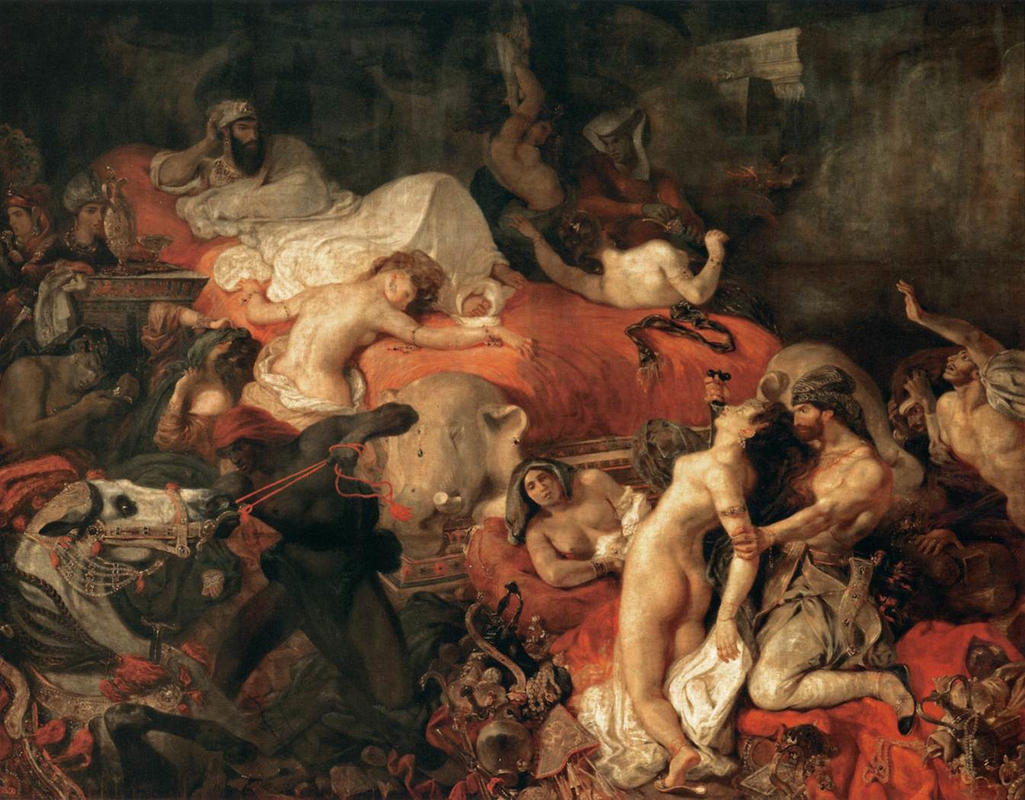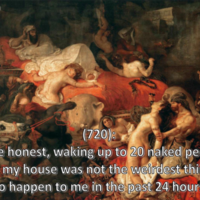More about Death of Sardanapalus
- All
- Info
- Shop

Sr. Contributor
Eugène Delacroix sends us a reminder to never drink and battle at the same time or suffer the fate of Sardanapalus's harem.
How not to die an agonizing death in the Seventh Century BC:
Step 1. Alcohol and battle don’t mix.
Step 2. Don’t marry Sardanapalus.
Step 3. Avoid being a sex slave or male prostitute.
Step 4. Try not to get castrated.
Step 5. Don’t be a horse or dog.
Step 6. Seriously, don’t marry Sardanapalus! We cannot stress this enough!
According to an apocryphal history by Diodorus, Sardanapalus was the most debauched Assyrian King of all time. One of his favorite hobbies was masquerading as a hooker in makeup and women’s clothes, and seeking pleasure with his numerous concubines, both male and female. Believing he had squashed a rebellion against his decadence, Sardanapalus declared victory prematurely. While his army was getting hammered in celebration, the rebels regrouped and laid siege to the capital Nineveh.
Sardanapalus reacted as any self-respecting disgraced hedonist would…by setting everyone on fire. His wives, concubines, eunuchs, slaves, dogs, horses and all his treasures were amassed in a giant funeral pyre and burned as the enemy broke through the walls.
Not surprisingly, the mix of violence and kinky sex appealed to Lord Byron, a man who reputedly banged his own sister and wife-swapped with his best friends Percy and Mary Shelley. Byron wrote a tragedy based on Diodorus, which Delacroix adapted into this painting. On what appears to be the set of a high-budget porno, Sardanapalus languishes on a divan as if he’s waiting for an orgy to commence while a bunch of mostly-naked hot people die hideously violent deaths around him … so basically what we have here is an 1827 episode of Game of Thrones.
Contemporary critics were not turned on. The austere Neoclassicists of the time found the composition cluttered, the colors lurid, and the sexual brutality obscene. The painting was taken down soon after its first debut, and was not put on public exhibition again for almost thirty years, when it was finally recognized as one of the first major works of Romantic art. In the critics’ defense, it’s not always easy to tell the difference between Romantic art and torture porn.
Delacroix’s version is actually tame compared to the original story by Diodorus. None of this mercy stabbing business. The wives, concubines, eunuchs and animals were boxed inside of the pyre and burned alive. Trapped in a flaming box with a bunch of terrified horses…not a good way to go. Sign me up for mercy stabbing, please!
Featured Content
Here is what Wikipedia says about The Death of Sardanapalus
The Death of Sardanapalus (La Mort de Sardanapale) is an oil painting on canvas by Eugène Delacroix, dated 1827. It currently hangs in the Musée du Louvre, Paris. A smaller replica, painted by Delacroix in 1844, is now in the Philadelphia Museum of Art.
The Death of Sardanapalus is based on the tale of Sardanapalus, a king of Assyria, from the historical library of Diodorus Siculus, the ancient Greek historian, and is a work of the era of Romanticism. This painting uses rich, vivid and warm colours, and broad brushstrokes. It was inspired by Lord Byron's play Sardanapalus (1821), and in turn inspired a cantata by Hector Berlioz, Sardanapale (1830), and also Franz Liszt's opera, Sardanapalo (1845–1852, unfinished).
Check out the full Wikipedia article about The Death of Sardanapalus

















Have to agree with Gryff: mercy stabbing does sound less annoying than being burned alive...